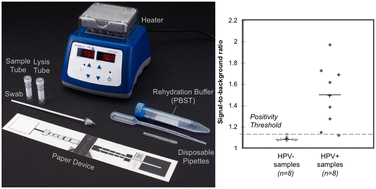A low-cost, paper-based hybrid capture assay to detect high-risk HPV DNA for cervical cancer screening in low-resource settings†
Abstract
Cervical cancer is a leading cause of cancer death for women in low-resource settings. The World Health Organization recommends that cervical cancer screening programs incorporate HPV DNA testing, but available tests are expensive, require laboratory infrastructure, and cannot be performed at the point-of-care. We developed a two-dimensional paper network (2DPN), hybrid-capture, signal amplification assay and a point-of-care sample preparation protocol to detect high-risk HPV DNA from exfoliated cervical cells within an hour. The test does not require expensive equipment and has an estimated cost of <$3 per test without the need for batching. We evaluated performance of the paper HPV DNA assay with short synthetic and genomic HPV DNA targets, HPV positive and negative cellular samples, and two sets of clinical samples. The first set of clinical samples consisted of 16 biobanked, provider-collected cervical samples from a study in El Salvador previously tested with careHPV and subsequently tested in a controlled laboratory environment. The paper HPV DNA test correctly identified eight of eight HPV-negative clinical samples and seven of eight HPV-positive clinical samples. We then performed a field evaluation of the paper HPV DNA test in a hospital laboratory in Mozambique. Cellular controls generated expected results throughout field testing with fully lyophilized sample preparation and 2DPN reagents. When evaluated with 16 residual self-collected cervicovaginal samples previously tested by the GeneXpert HPV assay (“Xpert”), the accuracy of the HPV DNA paper test in the field was reduced compared to testing in the controlled laboratory environment, with positive results obtained for all eight HPV-positive samples as well as seven of eight HPV-negative samples. Further evaluation showed reduction in performance was likely due in part to increased concentration of exfoliated cells in the self-collected clinical samples from Mozambique compared with provider-collected samples from El Salvador. Finally, a formal usability assessment was conducted with users in El Salvador and Mozambique; the assay was rated as acceptable to perform after minimal training. With additional optimization for higher cell concentrations and inclusion of an internal cellular control, the paper HPV DNA assay offers promise as a low-cost, point-of-care cervical cancer screening test in low-resource settings.

- This article is part of the themed collection: Lab on a Chip HOT Articles 2023


 Please wait while we load your content...
Please wait while we load your content...